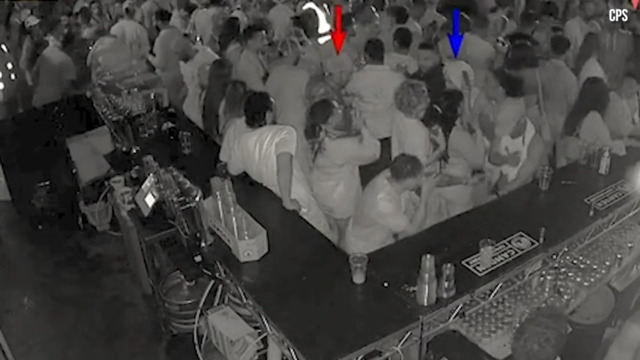Toxic Chemicals From Ohio Train Derailment: Building Contamination And Long-Term Effects

Table of Contents
Types of Toxic Chemicals Released and Their Properties
The derailment released a complex mixture of hazardous substances, many with severe health implications. Key chemicals include vinyl chloride, butyl acrylate, and ethylene glycol monobutyl ether. Understanding their individual properties is crucial to assessing the risk of building contamination.
-
Vinyl Chloride: This colorless gas is a known human carcinogen, meaning it can cause cancer. Its volatility means it can readily spread through the air, leading to long-term indoor air contamination. Even after the initial release, residual vinyl chloride can persist in building materials, posing a continuous threat.
-
Butyl Acrylate: This is a colorless liquid with a pungent odor, acting as an irritant to the skin, eyes, and respiratory system. While less volatile than vinyl chloride, butyl acrylate can persist on surfaces, contaminating floors, walls, and furniture, leading to ongoing exposure risks.
-
Ethylene Glycol Monobutyl Ether (EGMBE): This colorless liquid is also an irritant, affecting the eyes, skin, and respiratory tract. It's known to be readily absorbed through the skin, adding another layer of concern for building contamination.
The persistence, volatility, and toxicity of these chemicals dictate their potential to contaminate buildings and create long-term health hazards for residents. The specific characteristics of each chemical, along with its potential for interaction with other released substances, must be considered when assessing the scope of the problem.
Pathways of Building Contamination
The toxic chemicals released from the derailment could enter buildings through several pathways, leading to persistent contamination:
-
Airborne Contamination: Volatile chemicals like vinyl chloride can readily penetrate building envelopes, contaminating indoor air. This is especially concerning given the potential for long-term release from contaminated soil and materials. Poorly sealed windows and doors exacerbate this issue.
-
Surface Contamination: Less volatile chemicals, such as butyl acrylate, can contaminate surfaces through direct contact or through the deposition of airborne particles. This can include soil tracked into homes, contaminated rainwater, and settling of airborne pollutants onto surfaces. Building materials such as porous wood or fabrics can absorb these chemicals, potentially leading to slow and prolonged release.
-
Water Contamination: Groundwater contamination is a serious possibility, particularly given the potential for leaching of chemicals from contaminated soil. This could affect building water supplies, leading to exposure through drinking water and contact with contaminated plumbing.
The long-term persistence of these chemicals within building materials presents an ongoing threat, requiring careful and thorough remediation efforts. Materials like porous drywall, carpeting, and upholstery are particularly susceptible to absorbing and retaining these toxins.
Assessing and Mitigating Building Contamination
Assessing the extent of building contamination after the Ohio train derailment presents significant challenges. The complex mixture of chemicals and the varying pathways of contamination require a multifaceted approach:
-
Air Quality Testing: This involves measuring the concentration of volatile organic compounds (VOCs), including vinyl chloride and butyl acrylate, in the indoor air. Continuous monitoring may be necessary to evaluate long-term contamination.
-
Surface Sampling: Samples from various surfaces (floors, walls, furniture) can be analyzed to determine the presence and concentration of non-volatile chemicals like butyl acrylate. This provides information about the extent of surface contamination.
-
Water Testing: Testing the water supply is essential to determine whether groundwater contamination has affected building water sources. This includes testing for the presence of the released chemicals and any potential byproducts.
Remediation strategies depend on the type and extent of contamination. These can include:
-
Air Purification: Utilizing high-efficiency particulate air (HEPA) filters and specialized air scrubbers to remove airborne contaminants.
-
Surface Cleaning: Thorough cleaning and decontamination of affected surfaces using appropriate methods and cleaning agents.
-
Water Filtration: Installing appropriate filtration systems to remove contaminants from the building's water supply.
The effectiveness of these remediation techniques varies depending on the chemical involved and the degree of contamination. A tailored approach is essential, guided by professional environmental consultants experienced in handling similar situations.
Long-Term Health Effects on Residents
Exposure to the chemicals released from the Ohio train derailment poses significant long-term health risks to residents. The potential consequences include:
-
Cancer: Vinyl chloride is a known carcinogen, increasing the risk of various cancers with prolonged exposure.
-
Respiratory Problems: Exposure to irritants like butyl acrylate and EGMBE can lead to asthma, bronchitis, and other respiratory issues.
-
Reproductive Issues: Some of these chemicals have been linked to reproductive problems, affecting fertility and fetal development.
Establishing a direct causal link between exposure to these chemicals and specific health problems can be challenging. The complex mixture of chemicals released and the presence of pre-existing health conditions in the affected population add layers of complexity to epidemiological studies. However, the potential for serious health issues underscores the importance of long-term health monitoring for affected residents. This includes comprehensive medical evaluations, ongoing blood tests, and regular assessments to identify and manage health problems arising from exposure.
Conclusion
The Ohio train derailment's release of toxic chemicals presents a serious and ongoing threat to the health and well-being of affected communities. The potential for long-term building contamination and subsequent exposure necessitates thorough testing, effective remediation strategies, and comprehensive long-term health monitoring. Ignoring these crucial steps could have devastating consequences for the residents of this area. We urge continued research, transparent communication, and robust support for those impacted by this environmental disaster. Stay informed about the ongoing efforts to address the long-term effects of the toxic chemicals from the Ohio train derailment, and advocate for the necessary resources to ensure the safety and well-being of affected communities. Learning about building safety protocols following environmental disasters is crucial to protect yourself and your family in future emergencies.

Featured Posts
-
 Ofcom Investigation Launched Police Watchdog Challenges Chris Kaba Panorama
Apr 30, 2025
Ofcom Investigation Launched Police Watchdog Challenges Chris Kaba Panorama
Apr 30, 2025 -
 Skenes Strong Performance Overshadowed By Lackluster Offense
Apr 30, 2025
Skenes Strong Performance Overshadowed By Lackluster Offense
Apr 30, 2025 -
 Trump Approval Rating At 39 Impact Of Slow Travel On Presidency
Apr 30, 2025
Trump Approval Rating At 39 Impact Of Slow Travel On Presidency
Apr 30, 2025 -
 Emotional Farewell Amanda Owen Leaves Our Yorkshire Farm
Apr 30, 2025
Emotional Farewell Amanda Owen Leaves Our Yorkshire Farm
Apr 30, 2025 -
 Significant Disney Layoffs 200 Employees Affected 538 Shut Down
Apr 30, 2025
Significant Disney Layoffs 200 Employees Affected 538 Shut Down
Apr 30, 2025
